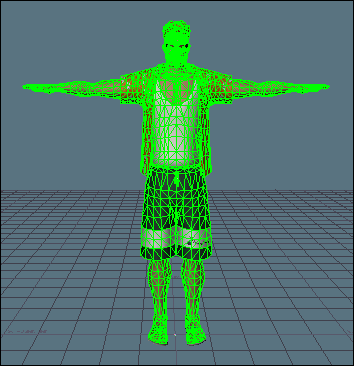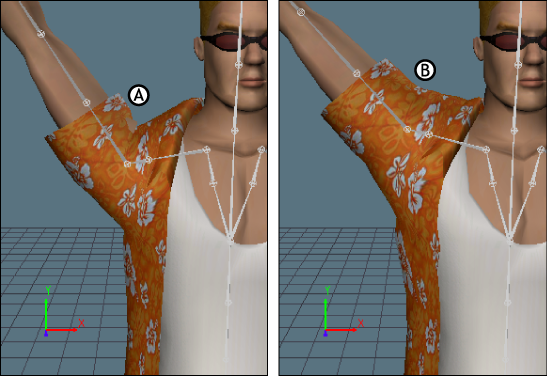For all character models, the skeleton provides their underlying structure. The outer appearance of each model is created by a geometric skin (or mesh) on which textures, colors, facial and body features are applied to form the body of the character. It is the skin that gives a model its distinct appearance.

Geometric skin gives the model its outer appearance. Model is shown in a T-stance
Your character model should be properly skinned before being used within MotionBuilder. A properly skinned model has its mesh reacting with its skeleton when the arms, legs, head, and other body parts move.
Some modeling software refers to this process as skinning while others refer to it as weighting.
Weighting defines to what extent the skin or mesh that envelopes a character follows the movements of its limbs. The skin consists of vertices that control its shape.
The weight applied to vertices determines how the skin or mesh deforms from its original shape as the bones translate or rotate. The goal is to set the weight of each vertex so that the skin or mesh it controls adjusts realistically as the character moves.
For example, in the following figure, A shows the shoulder mesh of the character deforms unnaturally as the shoulder is rotated on the Z-axis. B, in the following figure shows the same character with improved weighting on the shoulder vertices. The shoulder assumes a much more natural position as the shoulder is rotated on the Z-axis.

Mesh deformation A. Shoulder mesh deforms at an unnatural angle B. Shoulder mesh deforms naturally
Weight values are measured using a percentage. The higher the percentage, the closer the vertices follow the movements of the bone. For example, with a value set at 100%, the vertex follows the bone exactly. With a value set at 50%, the vertex moves only half as much as the bone.
For deformations to be realistic, you have to associate some vertices with more than one bone. In such a case, any change in the weight percentage relative to one bone adjusts the weighting of the other bones. For example, vertices along the shoulder of a character are influenced by movements of the arms, chest, or spine. To obtain realistic deformations, some shoulder vertices are weighted using arm bones and chest bones, while other vertices are weighted using only arm bones.
The weighting process takes a lot of practice before you can achieve the best balance between vertices. To make it easier to distinguish the influence of different bones on vertices, MotionBuilder indicates weight values using spectral color-coding. Different hues and color blends indicate which bones have the most and least influence.